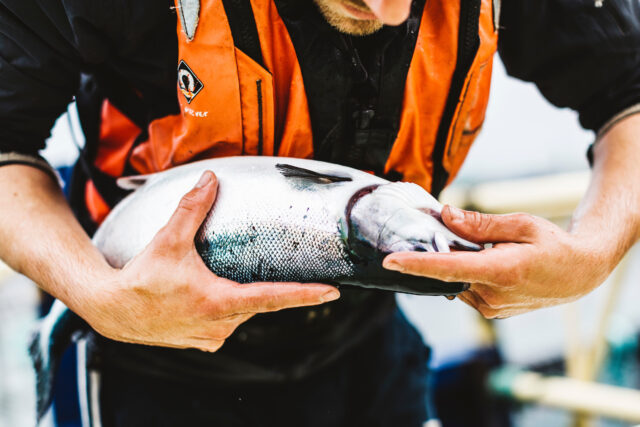
Fish welfare
Every farmer's priority is to protect their livestock and we're investing on a huge scale to do exactly that.

One of the key benefits of our 'prevention over cure' approach to fish health is that it has helped reduce our use of veterinary medicines.
As with human health however, there are some occasions when the use of medicine is essential, whether as a vaccination to proactively ward off disease or as a course of treatment in response to an emerging health challenge.
In each instance, the medicine is prescribed by a qualified veterinarian in accordance with strict protocols – both clinical and environmental.
That way, our salmon get the help they need with minimal impact on the surrounding environment.
We vaccinate each and every one of our young salmon prior to putting them out to sea pens. The result has been a marked decrease in the occurrence of bacterial diseases and, directly related to this, a reduction in the use of antibiotics.
Reflective of our ongoing pursuit of low to zero antibiotics, 2020 saw us achieve zero antibiotic use for the first time, with low-to-zero usage in the years thereafter.
Owing to challenging farming conditions in 2023, fish at seven of the company’s 46 active marine farms were prescribed antibiotics.
At all seven farms, these antibiotics resulted in decreased bacterial infection and rapid improvement in fish health, underlining the importance of the RUMA (Responsible Use of Medicines in Agriculture Alliance) ethos: ‘as little as possible, as much as necessary’.

We use a very limited number of veterinary medicines, each of which is licensed and approved as being safe to use on animals, in food production and in the marine environment in the prescribed doses.
These medicines can be grouped into two main types: bath treatments and in-feed treatments.
Bath treatments
Salmosan®Vet and Azasure
Both Salmosan®Vet and Azasure contain the active ingredient azamethiphos which is a biodegradable organophosphorus medicine.
Organophosphorus compounds have been, and still are, used extensively in fruit and vegetable production, in sheep dips and are a major component in non-prescription flea collars widely used by pet owners.
In farmed salmon, these medicines are administered as a bath treatment. Once the treatment is complete the water containing medicine residues is released. The residues are rapidly diluted as they are dispersed into the surrounding water where they are broken down naturally.
AMX
The medicine AMX contains the active ingredient deltamethrin; a pyrethroid. This group of organic compounds are used for controlling insect pests in agriculture, public health and animal health.
AMX is administered as a bath treatment. Once the treatment is complete, the water containing medicine residues is released. As the ingredient deltamethrin is not water soluble, it quickly sinks from the water column to the seabed where it is broken down.
Paramove®
Paramove® contains the active ingredient hydrogen peroxide which is common to many human, domestic and cosmetic products. It is administered as a dilute bath treatment at or below 0.15% concentration hydrogen peroxide – that’s a 10th of the strength used in a typical mouthwash – and rapidly breaks down into just water and oxygen.
SEPA considers that, when used in accordance with its product and CAR licence, it presents next to no environmental risk, therefore no numeric limits are imposed on its use.

In-feed treatments
SLICE®
Containing the active ingredient emamectin benzoate, SLICE® is an anti-parasitic treatment similar to those administered topically at home to cats and dogs to protect against fleas or worms.
It’s administered as an in-feed treatment at a level below the fish’s normal appetite to minimise the risk of medicated food being uneaten.
Emamectin benzoate has low water solubility and the small amount present in fish faeces binds to sediment particles until it is broken down.
Anaesthesia
Farmed salmon are routinely examined for overall health, including the presence of any parasites. To ensure their well-being throughout this process, our fish are anaesthetised before handling. This involves the use of small quantities of anaesthetics which, like the lice treatments, are licensed medicines used under prescription.

Our strict veterinary protocols ensure the continued absence of medicinal residues in our end products, operating a stringent internal quality system in addition to the statutory Veterinary Medicines Directorate surveillance programme which has detected no medicinal residues in our salmon destined for market.
Using approved medicines under prescription and in accordance with SEPA guidance is our way of looking after the health of our fish in a way that’s safe for other marine life and the environment too.
As the science and tools at our disposal continue to advance, so too will our understanding of what more can be done, and we continue to work closely with regulators to ensure that we are doing everything we can to minimise our impact on the local marine environment and surrounding areas while maximising fish health and welfare.